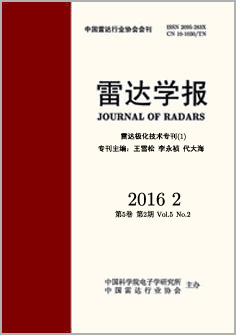| [1] |
Lee J S and Pottier E. 极化合成孔径雷达成像基础与应用[M]. 北京: 电子工业出版社, 2013: 199-223. Lee J S and Pottier E. Polarimetric Radar Imaging: From Basics to Applications[M]. Beijing: Publishing House of Electronic Industry, 2013: 199-223.
|
| [2] |
滑文强, 王爽, 侯彪. 基于半监督学习的SVM-Wishart极化SAR图像分类方法[J]. 雷达学报, 2015, 4(1): 93-98. Hua Wen-qiang, Wang Shuang, and Hou Biao. Semi-supervised learning for classification of polarimetric SAR images based on SVM-Wishart[J]. Journal of Radars, 2015, 4(1): 93-98.
|
| [3] |
Lee J S, Grunes M R, and Kwok R. Classification of multilook polarimetric SAR imagery based on complex Wishart distribution[J]. International Journal of Remote Sensing, 1994, 15(11): 2299-2311.
|
| [4] |
Cloude S R and Pottier E. An entropy based classication scheme for land applications of polarimetric SAR[J]. IEEE Transactions on Geoscience and Remote Sensing, 1997, 35(1): 68-78.
|
| [5] |
Tzeng Y C and Chen K S. A fuzzy neural network to SAR image classification[J]. IEEE Transactions on Geoscience and Remote Sensing, 1998, 36(1): 301-307.
|
| [6] |
Lee J S, Grunes M R, Ainsworth T L, et al.. Unsupervised classification using polarimetricdecomposition and the complex Wishart classifier[J]. IEEE Transactions on Geoscience and Remote Sensing, 1999, 37(5): 2249-2258.
|
| [7] |
Famil L F, Pottier E, and Lee J S. Unsupervised classification of multifrequency and fully polarimetric SAR images based on the H/A/-Wishart classifier[J]. IEEE Transactions on Geoscience and Remote Sensing, 2001, 39(11): 2332-2342.
|
| [8] |
Lee J S, Grunes M R, Pottier E, et al.. Unsupervised terrain classification preserving polarimetric scattering characteristics[J]. IEEE Transactions on Geoscience and Remote Sensing, 2004, 42(4): 722-731.
|
| [9] |
Cao F, Hong W, and Wu Y R. An unsupervised segmentation with an adaptive number of clusters using theSPAN/H//Aspace and the complex Wishart clusteringfor fully polarimetric SAR data analysis[J]. IEEE Transactions on Geoscience and Remote Sensing, 2007, 45(11): 3454-3467.
|
| [10] |
Lardeux C, Frison P L, Tison C, et al.. Support vector machine for multifrequency SAR polarimetric data classification[J]. IEEE Transactions on Geoscience and Remote Sensing, 2009, 47(12): 4143-4151.
|
| [11] |
Cloude S R and Pottier E. A review of target decomposition theorems in radar polarimetry[J]. IEEE Transactions on Geoscience and Remote Sensing, 1996, 34(2): 498-518.
|
| [12] |
周伟, 孙艳丽, 许成斌, 等. 一种多极化SAR 舰船目标与方位向模糊鉴别方法[J]. 雷达学报, 2015, 4(1): 84-92. Zhou Wei, Sun Yan-li, Xu Cheng-bin, et al.. A method for discrimination of ship target and azimuth ambiguity in multi-polarimetric SAR imagery[J]. Journal of Radars, 2015, 4(1): 84-92.
|
| [13] |
Gou S P, Qiao X, Zhang X R, et al.. Eigenvalue analysis-based approach for POL-SAR image classification[J]. IEEE Transactions on Geoscience and Remote Sensing, 2014, 52(2): 805-818.
|
| [14] |
李航. 统计学习方法[M]. 北京: 清华大学出版社, 2012: 37-53. Li Hang. Statistical Learning Methods[M]. Beijing: Tsinghua University Press, 2000: 37-53.
|
| [15] |
王鑫. 基于高斯混合模型的k均值初始化EM 算法的研究[J]. 商丘师范学院学报, 2012, 28(12): 11-14. Wang Xin. Gaussian mixture model based k-means to initialize the EM algorithm[J]. Journal of Shangqiu Normal University, 2012, 28(12): 11-14.
|
| [16] |
Dempster A P, Laird N M, and Rubin D B. Maximum-likelihood from incomplete data via the EM algorithm[J]. Journal of the Royal Statistical Society, 1977, 39(1): 1-38.
|
| [17] |
Liu B, Hu H, Wang H Y, et al.. Superpixel-based classification with an adaptive number of classes for polarimetric SAR images[J]. IEEE Transactions on Geoscience and Remote Sensing, 2013, 51(2): 907-924.
|




 Submit Manuscript
Submit Manuscript Peer Review
Peer Review Editor Work
Editor Work




 DownLoad:
DownLoad: